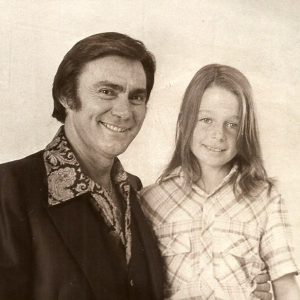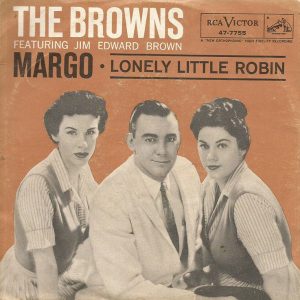calsfoundation@cals.org
Jim Ed Brown (1934–2015)
Country and western music star Jim Ed Brown’s career spanned more than half a century since the early 1950s. He was a solo vocalist and a member of two singing groups: the Browns and a duo consisting of himself and singer Helen Cornelius. He performed on numerous radio and television programs, hosting some and starring on others, and became a member of the Grand Ole Opry.
James Edward Brown was born in Sparkman (Dallas County) on April 1, 1934, to Floyd and Birdie Brown; he had two sisters. He grew up in the timber country near Pine Bluff (Jefferson County), and his father hauled logs for a living and was also a farmer. Brown formed a musical duo with his sister Maxine after they graduated from high school. They soon signed with California’s Fabor Records and issued their first release, “Looking Back to See,” in 1954. The song was a hit, but their contract with Fabor Robison, proprietor of the company bearing his name, produced no royalties from its sales.
Nevertheless, the song—which the pair wrote during a period when they were performing on Barnyard Frolics, a radio program originating on Little Rock (Pulaski County) station KLRA—carried them to modest national prominence. They joined the Louisiana Hayride radio lineup and began making regular appearances on the Ozark Jubilee, hosted by Red Foley, in 1955. The pair’s younger sister Bonnie joined the group that same year, and the Browns, as they were known, started a steady climb to stardom. They first released the hit “Here Today and Gone Tomorrow.” They then signed with RCA Records (at the behest of guitarist and executive Chet Atkins) in 1956 and quickly produced two number-one hits: “I Take the Chance” and “I Heard the Bluebird Sing.”
After a two-year tour of duty as a draftee in the armed services, Brown reunited with his sisters, and together they struck gold in 1959 with “The Three Bells.” It sold more than a million copies and was the first number-one country smash to cross over to number one on the pop and rhythm and blues charts. That was followed by two more hits: “The Old Lamplighter” and “Scarlet Ribbons.” In 1963, the Browns joined the Grand Ole Opry.
The next few years brought more success to the group as Nashville, Tennessee, slowly changed its sound from the rustic hoedowns of the past to a contemporary orchestral style that was greatly influenced by the Browns. However, by the mid-1960s, Maxine and Bonnie wearied of the struggle to sustain both family lives and show-business careers, causing them to retire from the trio.
Jim Ed Brown continued as a solo act, and, in 1967, he hit a solo peak with his classic “Pop-A-Top,” which he followed with “Southern Loving,” “Sometime Sunshine,” and “Morning.” He had a six-season occasional spot as co-host of the weekly syndicated TV series Nashville on the Road, starting in 1976. He then teamed with Helen Cornelius for a country duo act that resulted in the hits “Don’t Bother to Knock,” “Saying Hello, Saying I Love You, Saying Goodbye,” and “Lying in Love with You.”
Brown began working with The Nashville Network (TNN) in 1983. He was a prominent figure there for six years on the You Can Be a Star program. He went on, beginning in 2003, to host the Country Greats Music Radio Show. He remained a member of the Grand Ole Opry, on which he made about thirty appearances a year. In late 2014, he revealed that he had been diagnosed with lung cancer and was taking several months off for treatment. In early 2015, he released a new album, In Style Again, and began touring again. In March 2015, it was announced that the Browns would be inducted into the Country Music Hall of Fame.
Brown died on June 11, 2015, at the Williamson Medical Center in Franklin, Tennessee. Brown had been given a medallion commemorating his Country Music Hall of Fame membership in the hospital on June 4.
For additional information:
Brown, Maxine. Looking Back to See: A Country Music Memoir. Fayetteville: University of Arkansas Press, 2005.
Campbell, Bell. “Opry Singer Brown Dead at 81.” Arkansas Democrat-Gazette, June 12, 2015, p. 2A.
Jim Kelton
University of Arkansas, Fayetteville


 Jim Ed Brown and Daughter
Jim Ed Brown and Daughter  Jim Ed Brown
Jim Ed Brown  The Browns
The Browns  Single by the Browns
Single by the Browns 




Comments
No comments on this entry yet.